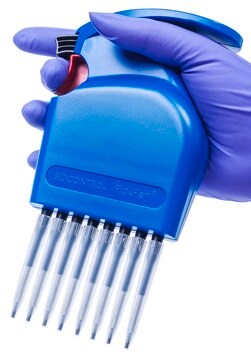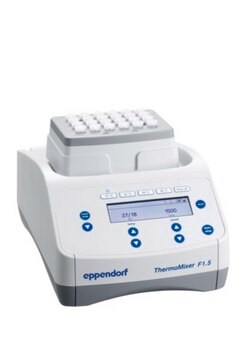D1947
Diffinity RapidTip®
for PCR Purification
Sinonimo/i:
PCR clean up tip, PCR purification tip, PCR reaction clean-up tip
Autenticatiper visualizzare i prezzi riservati alla tua organizzazione & contrattuali
About This Item
Prodotti consigliati
Livello qualitativo
Forma fisica
solid
Produttore/marchio commerciale
(Diffinity Genomics, Inc.)
Capacità
50(µL)
Temperatura di conservazione
room temp
Cerchi prodotti simili? Visita Guida al confronto tra prodotti
Categorie correlate
Descrizione generale
Diffinity RapidTip effectively removes dNTPs, primers and primer dimers while providing greater than 90% recovery of pure DNA fragments from 100 bp to 10 kb. The functional pipette tip contains everything you need for PCR purification. The tip is filled with a proprietary adsorption technology that has a differential affinity for PCR components. The dispensed solution yields purified, high quality DNA ready for downstream applications such as DNA sequencing, SNP analysis and microarray printing.
Applicazioni
Diffinity RapidTip® has been used in PCR product purification.
Caratteristiche e vantaggi
- Single step
- Recovers 90% of high quality dsDNA
- Optimized for 25 μL RXN
Note legali
RapidTip is a registered trademark of Diffinity Genomics, Inc.
Certificati d'analisi (COA)
Cerca il Certificati d'analisi (COA) digitando il numero di lotto/batch corrispondente. I numeri di lotto o di batch sono stampati sull'etichetta dei prodotti dopo la parola ‘Lotto’ o ‘Batch’.
Possiedi già questo prodotto?
I documenti relativi ai prodotti acquistati recentemente sono disponibili nell’Archivio dei documenti.
H Kühlwein et al.
Journal of applied microbiology, 115(5), 1091-1106 (2013-07-31)
To assess the effects of dietary Saccharomyces cerevisiae β-(1,3)(1,6)-D-glucan supplementation (MacroGard(®)) on mirror carp (Cyprinus carpio L.) intestinal microbiota and ultrastructure of the enterocyte apical brush border. Carp were fed either a control diet or diets supplemented with 0.1, 1
Sarah L Dean et al.
Molecular ecology, 23(6), 1364-1378 (2013-10-12)
Nitrogen (N) deposition rates are increasing globally due to anthropogenic activities. Plant community responses to N are often attributed to altered competitive interactions between plants, but may also be a result of microbial responses to N, particularly root-associated fungi (RAF)
Michael J Goblirsch et al.
PloS one, 8(7), e69831-e69831 (2013-07-31)
A major hindrance to the study of honey bee pathogens or the effects of pesticides and nutritional deficiencies is the lack of controlled in vitro culture systems comprised of honey bee cells. Such systems are important to determine the impact
Teruaki Nakatsuji et al.
Nature communications, 4, 1431-1431 (2013-02-07)
Commensal microbes on the skin surface influence the behaviour of cells below the epidermis. We hypothesized that bacteria or their products exist below the surface epithelium and thus permit physical interaction between microbes and dermal cells. Here to test this
Parag Vaishampayan et al.
The ISME journal, 7(2), 312-324 (2012-10-12)
The advent of phylogenetic DNA microarrays and high-throughput pyrosequencing technologies has dramatically increased the resolution and accuracy of detection of distinct microbial lineages in mixed microbial assemblages. Despite an expanding array of approaches for detecting microbes in a given sample
Il team dei nostri ricercatori vanta grande esperienza in tutte le aree della ricerca quali Life Science, scienza dei materiali, sintesi chimica, cromatografia, discipline analitiche, ecc..
Contatta l'Assistenza Tecnica.








